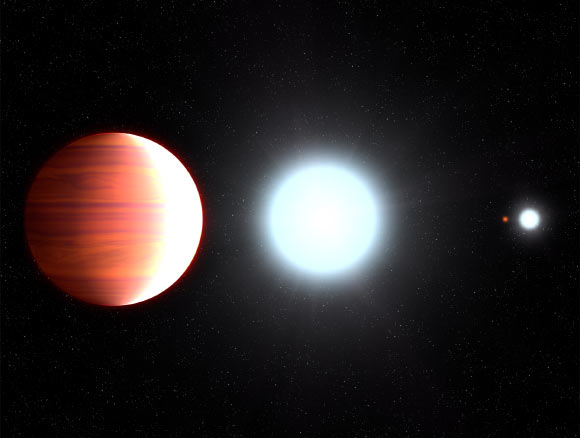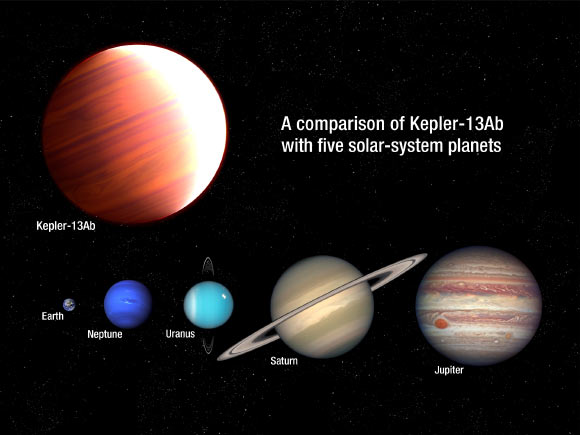The NASA/ESA Hubble Space Telescope has found a blistering hot-Jupiter exoplanet where it ‘snows’ titanium dioxide, the active ingredient in sunscreen. The Hubble observations are the first detections of this ‘snow-out’ process — called a ‘cold trap’ — on an exoplanet.

This illustration shows Kepler-13Ab that circles very close to its host star, Kepler-13A. In the background is the star’s binary companion, Kepler-13B, and the third member of the multiple-star system is the orange dwarf star Kepler-13C. Image credit: NASA / ESA / G. Bacon, STScI.
The giant exoplanet in question, called Kepler-13Ab, is approximately 1,730 light-years from Earth and is nearly 6 times more massive than Jupiter.
Penn State astronomer Dr. Thomas Beatty and co-authors targeted Kepler-13Ab because it is one of the hottest of the known planets, with a dayside temperature of nearly 5,000 degrees Fahrenheit (2,760 degrees Celsius).
Kepler-13Ab is so close to its parent star, Kepler-13A, that it is tidally locked, so one side always faces the star while the other side is in permanent darkness.
The astronomers discovered that titanium dioxide snowfall happens only on the planet’s nighttime side.
“Powerful winds carry the titanium oxide gas around to the colder nighttime side, where it condenses into crystalline flakes, forms clouds, and precipitates as snow,” they explained.
“Kepler-13Ab’s strong surface gravity — about 6 times greater than Jupiter’s — pulls the titanium oxide snow out of the upper atmosphere and traps it in the lower atmosphere.”
These kinds of observations provide insight into the complexity of weather and atmospheric composition on exoplanets, and may someday be applicable to analyzing Earth-size planets for habitability.
“In many ways, the atmospheric studies we’re doing now on these gaseous ‘hot Jupiter’ kinds of planets are test beds for how we’re going to do atmospheric studies of terrestrial, Earth-like planets,” Dr. Beatty said.
“Understanding more about the atmospheres of these planets and how they work will help us when we study smaller planets that are harder to see and have more complicated features in their atmospheres.”

This is an artist’s impression of Kepler-13Ab as compared in size to several planets in our Solar System. Image credit: NASA / ESA / A. Feild, STScI.
“Understanding what sets the climates of other worlds has been one of the big puzzles of the last decade,” said Penn State astronomer Dr. Jason Wright.
“Seeing this cold-trap process in action provides us with a long sought and important piece of that puzzle.”
The Hubble observations confirm a theory from several years ago that this kind of precipitation could occur on massive, hot planets with powerful gravity.
“Presumably, this precipitation process is happening on most of the observed hot Jupiters, but those gas giants all have lower surface gravities than Kepler-13Ab,” Dr. Beatty said.
“The titanium oxide snow doesn’t fall far enough in those atmospheres, and then it gets swept back to the hotter dayside, revaporizes, and returns to a gaseous state.”
The findings are published in the Astronomical Journal.
_____
Thomas G. Beatty et al. 2017. Evidence for Atmospheric Cold-trap Processes in the Noninverted Emission Spectrum of Kepler-13Ab Using HST/WFC3. AJ 154, 158; doi: 10.3847/1538-3881/aa899b







